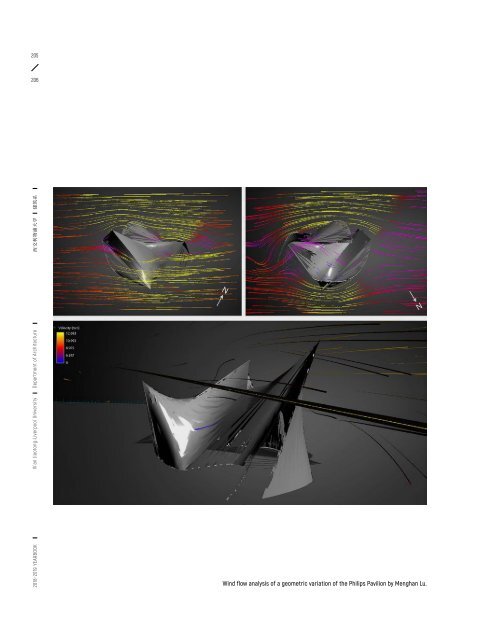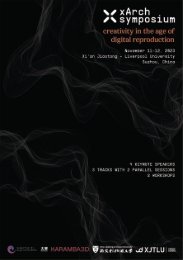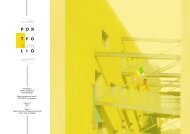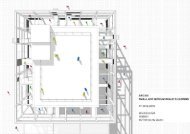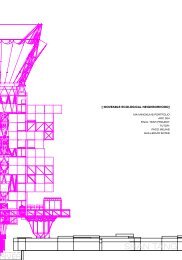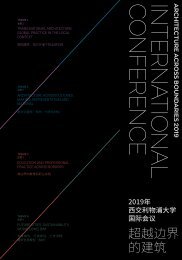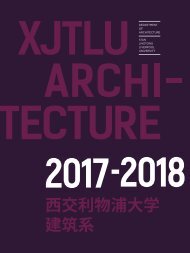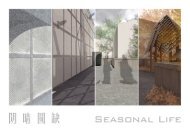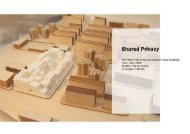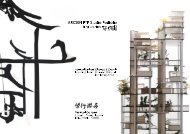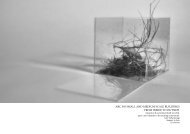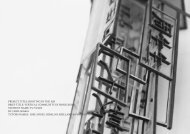YEARBOOK 2018 - 2019 | XJTLU DEPARTMENT OF ARCHITECTURE
The sixth edition of the yearbook of the Department of Architecture at Xi'an Jiaotong-Liverpool University presents student works created during the academic year 2018 - 2019. The yearbook exemplifies the new model for Chinese architectural education for which the department was commended by the Royal Institute of British Architects (RIBA). It is also a showcase of the creative culture that has guided our students towards successful international careers as responsible and creative architectural designers. The Department of Architecture at XJTLU offers RIBA Part 1, 2 and 3.
The sixth edition of the yearbook of the Department of Architecture at Xi'an Jiaotong-Liverpool University presents student works created during the academic year 2018 - 2019. The yearbook exemplifies the new model for Chinese architectural education for which the department was commended by the Royal Institute of British Architects (RIBA). It is also a showcase of the creative culture that has guided our students towards successful international careers as responsible and creative architectural designers. The Department of Architecture at XJTLU offers RIBA Part 1, 2 and 3.
You also want an ePaper? Increase the reach of your titles
YUMPU automatically turns print PDFs into web optimized ePapers that Google loves.
205<br />
206<br />
ARC403<br />
Applied Technology in Architecture<br />
<strong>2018</strong>-<strong>2019</strong> <strong>YEARBOOK</strong> Xi’an Jiaotong-Liverpool University Department of Architecture 西 交 利 物 浦 大 学 建 筑 系<br />
Wind flow analysis of a geometric variation of the Philips Pavilion by Menghan Lu.<br />
Level 4<br />
( Year 1 | Semester 1 )<br />
Module Credits<br />
5<br />
Module Leader<br />
Thomas Fischer<br />
Teaching Team<br />
Thomas Wortman<br />
Number of Students<br />
12<br />
Applied Technology in Architecture introduces students to the mutuallychallenging<br />
relationship between architecture and applied technology,<br />
which has characterised architecture and construction throughout<br />
history. The module examines and explores case studies of architectural<br />
impetus on technological innovation, as well as case studies of advanced<br />
technology applications in the design, representation, evaluation, project<br />
management, construction and operation of architectural projects. The<br />
module is taught in a variety of teaching modes, including lectures,<br />
seminars, workshops and group tutorials. In this academic year, the<br />
theme of Applied Technology in Architecture focused on the Philips<br />
Pavilion designed by Le Corbusier and Iannis Xenakis for the Philips<br />
Company at the 1958 Brussels World’s Fair. The module investigated<br />
the integration of architectural and technological concerns in the<br />
schematic design of contemporary variations of the Philips Pavilion,<br />
and considered issues including digital representation, 3D modelling,<br />
geometric rationalisation, materials, material costing, construction,<br />
rapid prototyping, environmental simulation (occupant comfort with<br />
regards to wind flow and daylighting), as well as Python scripting. The<br />
module developed students’ technical skills in particular with regards to<br />
Rhino3D, Grasshopper and the building physics simulation tools DIVA<br />
and Autodesk Flow.<br />
Level 04 – Year 1<br />
M Arch Des Programme


